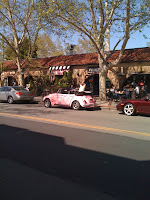








various pictures of Bret Harte at different ages/graveyard/grave headstone and Bret Harte School
Bret Harte was one of the West's most famous writers and he appeared in many articles in national magazines like the Atlantic Monthly and several New York magazines to name a few. Bret Harte in March1854, when he was young at an age of 18, came to California to stay with his parents and was already a writer and it showed with his grisly tales for his articles and also poetry, that was read by many in the East as tales of adventure and harshness in the wilds of the West.It was in September of 1856, that he became a tutor for Abner Bryant's four sons, Tom, Wise, George and Jonathan which gave the experience of living in the wilds under the big mountian called Mt Diablo. It was thought that the experience with the Bryant boys in the wilds of Tassajara helped to give those writings their wild edge and veracity.The Bryants had a ranch near Alamo Creek in the Tassajara Valley( now Blackhawk area) and their stock included 83 Spanish mares and horses, 238 head of cattle, 652 Spanish sheep, two wagons and one buggy.
Bret Harte in a letter to his sister explained the wildness of the area he was living in these words and alot more on October 8, 1856,"had four young sons, and not caring to have them grow up like range-cattle, he decided to have a tutor....There is nothing of the rural character of a farm, saving the corral at the bottom of the field and the haystack at the top, and the whole place is as wild as the god of nature made it". "Bryant was not really a farmer or rancher but a"Drover" and lived in a mere shanty that might be as well a hunters cabin in the wilderness".
Harte in his letters back home noted that Bryant was a very religious man and that autumn, the young writer joined the Bryants at an evangelical camp meeting in the valley. It was after this meeting that the young Harte later wrote his famous piece called "An Apostle of the Tules" which described the festive and revival atmosphere of the meeting and he begins the piece with Oct 10, 1856. Other works that drew and showed his wild life in Danville include the famous "A Legend of Monte Diablo" from the Atlantic Monthly article of October 1863, "Cressy, The Convalescence of Jack Hamlin", and "A First Family of Tassajara....The Queen of the Pirate Isle".
Bret Harte in a letter to his sister explained the wildness of the area he was living in these words and alot more on October 8, 1856,"had four young sons, and not caring to have them grow up like range-cattle, he decided to have a tutor....There is nothing of the rural character of a farm, saving the corral at the bottom of the field and the haystack at the top, and the whole place is as wild as the god of nature made it". "Bryant was not really a farmer or rancher but a"Drover" and lived in a mere shanty that might be as well a hunters cabin in the wilderness".
Harte in his letters back home noted that Bryant was a very religious man and that autumn, the young writer joined the Bryants at an evangelical camp meeting in the valley. It was after this meeting that the young Harte later wrote his famous piece called "An Apostle of the Tules" which described the festive and revival atmosphere of the meeting and he begins the piece with Oct 10, 1856. Other works that drew and showed his wild life in Danville include the famous "A Legend of Monte Diablo" from the Atlantic Monthly article of October 1863, "Cressy, The Convalescence of Jack Hamlin", and "A First Family of Tassajara....The Queen of the Pirate Isle".
He also wrote classic California Gold rush pieces like "The Outcasts of Poker Flat" and "The Luck of Roaring Camp" along with the now famous poem "Plain Language from Truthful James" along many others.
Bret Harte also worked with such writers as Samuel Clemens(aka mark Twain), Charles Warren Stoddard and Prentice Mulford while writing for San Franscico's "The Californian" newspaper.
Mark Twain had said and also criticize Harte's pieces as complete nonsense when asked about Bret Harte's writing and said they were not worth the effort.
Harte historical significance are seen in that he romanticized the California gold rush period but he also showed the readers in the East, the romantic side of the West but also at the same time also showed the harshness and isolation of the West also. He was a little more critical of the West than say Clemens, as he showed a lot more of the harshness and brutal side of him living in the California wilderness, as he put it. This put him at odds with many of the West's greatest writers and made him a radical in that sense of writers. Young Bret Harte stay in Danville was brief to a few years but he got the glimpse of the West and how brutal but beautiful it was, giving a leg up on his writing and how he would pursue his writing in romanticizing and showing the harshness of the West, the way he did.













+2.jpg)
















































